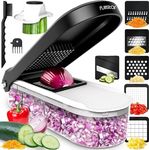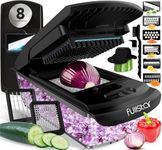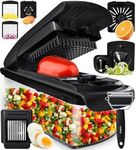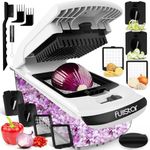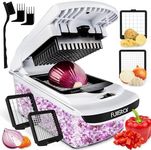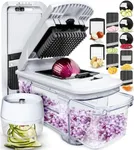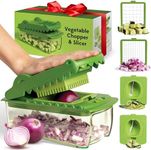Buying Guide for the Best Vegetable Choppers
Choosing the right vegetable chopper can make meal prep much faster and easier, especially if you cook often or like to prepare fresh salads, salsas, or stir-fries. The best chopper for you depends on how much you cook, the types of vegetables you use, and how much effort you want to put into chopping. Understanding the key features will help you find a chopper that fits your kitchen habits and makes your cooking experience more enjoyable.Type (Manual vs. Electric)The type of vegetable chopper refers to whether it is operated by hand (manual) or powered by electricity (electric). Manual choppers usually require you to push, pull, or twist to chop the vegetables, making them simple, portable, and easy to clean. Electric choppers use a motor to do the chopping for you, which is faster and requires less effort, but they need a power source and can be bulkier. If you want something quick and easy for small jobs or outdoor use, a manual chopper is a good choice. If you often chop large quantities or want to save time and effort, an electric chopper might suit you better.
Blade Material and DesignThe blades are the most important part of a chopper, as they do the actual cutting. Most choppers use stainless steel blades because they are sharp, rust-resistant, and durable. The design of the blades (straight, zigzag, or grid) affects how finely or coarsely your vegetables are chopped. If you want versatility, look for choppers with interchangeable blades or multiple cutting options. For basic chopping, a single sharp blade is usually enough. Think about what kinds of cuts you need most often—dicing, slicing, or mincing—and choose a chopper that matches your needs.
CapacityCapacity refers to how much food the chopper can hold at one time. Smaller choppers are compact and easy to store, but they may require you to chop in batches if you’re preparing food for several people. Larger choppers can handle more vegetables at once, which is convenient for big families or meal prepping. Consider how much you usually cook at once: if you often prepare meals for one or two people, a small chopper is fine; for bigger households or batch cooking, a larger capacity is more practical.
Ease of CleaningCleaning a vegetable chopper can be quick or tedious depending on its design. Some choppers have simple parts that are easy to rinse or are dishwasher-safe, while others have more complex mechanisms that can trap food and require careful cleaning. If you want to save time and avoid frustration, look for a chopper with removable blades and parts that are easy to wash. If you don’t mind a bit of extra cleaning, you might prioritize other features instead.
Safety FeaturesSafety features help prevent accidental cuts or injuries while using the chopper. Some choppers have non-slip bases, finger guards, or locking mechanisms to keep the blades covered when not in use. If you have children in the kitchen or are concerned about safety, these features are especially important. Choose a chopper that feels stable and secure during use, and make sure you’re comfortable with how it operates.
Size and StorageThe size of the chopper affects how much space it takes up on your countertop or in your cabinets. Compact choppers are easy to store and great for small kitchens, while larger models may need more dedicated space. If you have limited storage, look for a chopper that can be disassembled or has a compact design. If space isn’t an issue, you can focus more on capacity and features.


